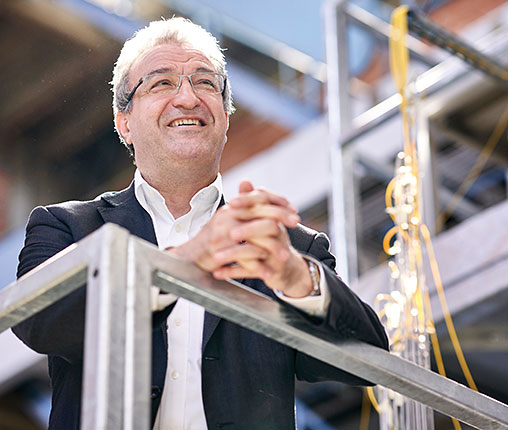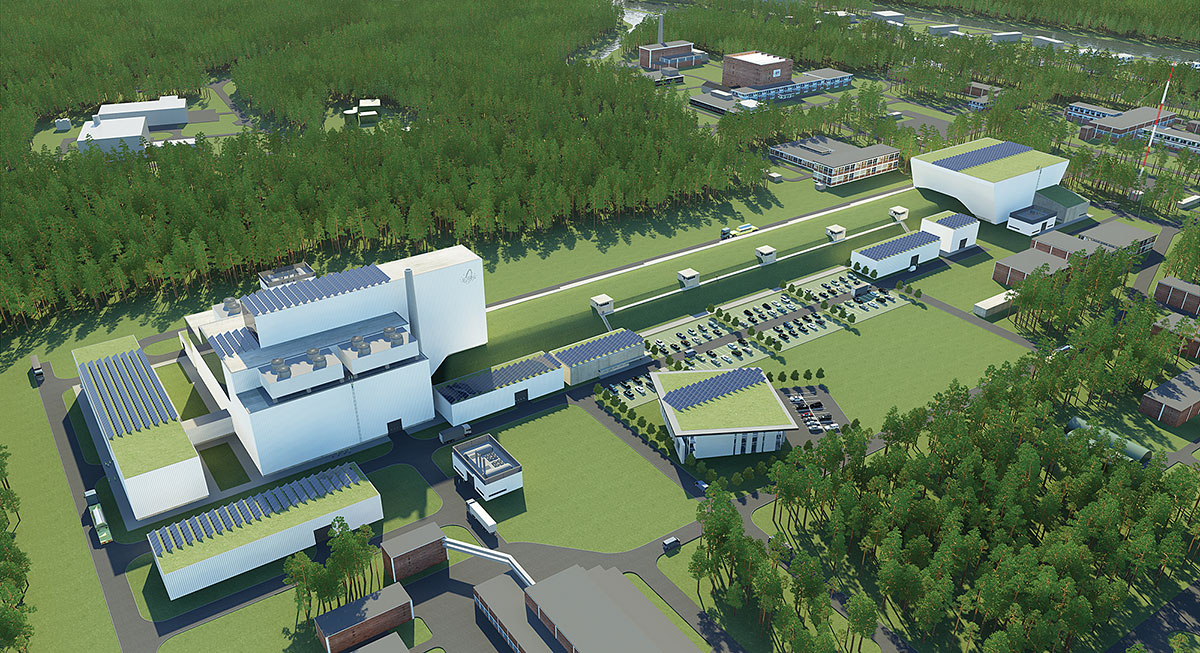Belgium presses on with accelerator-driven research reactor
DOI: 10.1063/PT.3.4089
An international project that marries a particle accelerator and a nuclear reactor to create the first fast-neutron accelerator-driven system (ADS) is moving forward in Belgium. Two decades in the works, MYRRHA (multipurpose hybrid research reactor for high-tech applications) is designed to study material properties, reactor safety, advanced fuels, and nuclear waste transmutation. It will also be used to produce and develop medical isotopes.
Critics say that MYRRHA proponents are overselling the project. “One might think transmutation is on the list because they know they can get money for it,” says Friederike Frieß, a postdoctoral researcher at the Institute of Safety and Risk Sciences at the University of Natural Resources and Life Sciences in Vienna. Research on neutrons and materials is fine, she says, but transmutation and the fuel cycle present proliferation risks.
In September the Belgian government committed €558 million ($637 million) to the project. That money will be used to build a 100 MeV linear particle accelerator and a proton target facility at the country’s nuclear reactor center in Mol and to support operations and R&D toward the full MYRRHA. The project received the stamp of approval from the European Strategy Forum on Research Infrastructures in 2010 (see “Europe updates research infrastructure priorities,” 16 October 2018
The total construction cost, including increasing the accelerator energy to 600 MeV and installing the reactor, is estimated at €1.6 billion. The plan is to start using the 100 MeV experimental facilities in 2027 and to reach full capabilities in 2033.
Critical tests
In an ADS, protons are revved up in a particle accelerator and fired at a heavy-metal target. The protons knock out neutrons. Those spallation-generated neutrons induce fission in a surrounding blanket containing fissionable material. A main attraction of the ADS concept is that runaway nuclear reactions can be readily forestalled by turning off the accelerator.
The idea for accelerator-driven reactors, also known as energy amplifiers, has been around since the mid 1940s. In the early 1990s, then CERN director general Carlo Rubbia proposed using an ADS with thorium-232 as the fuel: 232Th captures a neutron to become 233Th. A decay chain then leads to uranium-233, which fissions and releases energy. Thorium-232 doesn’t readily fission and therefore can’t cause chain reactions. It’s also among the most abundant heavy elements in Earth’s crust.
In the MYRRHA setup a horizontal 300-meter-long linac would accelerate protons and then bend them downward to hit a spallation target. The accelerator will use superconducting magnets and cavities to achieve a high acceleration gradient, enhance reliability, and allow for a continuous 2–4 mA beam. At 600 MeV, the proton power would be 1.2–2.4 MW and about 20 neutrons would be generated per incident proton. The neutrons would have a median energy of a few hundred keV and a peak approaching 600 MeV. (In reactor physics, neutrons of a few MeV are generally considered fast.)
MYRRHA would use a molten alloy of lead and bismuth as a reactor coolant. “It’s been used only for submarine nuclear reactors in Russia,” says project leader Hamid Aït Abderrahim. It has a relatively low melting temperature (around 125 ˚C), and it is less chemically reactive and therefore safer than sodium, the coolant used in most fast-spectrum reactors. The liquid would also serve as the spallation target and coolant.
In the MYRRHA design, a portion of the most energetic spallation neutrons are diverted for materials studies related to fusion reactors. And the isotope work will bypass the proton target and reactor and instead siphon 100–200 µA from the main proton beam to create isotopes using independent targets.
The facility is designed to be operable either in a self-sustaining, critical mode or in a subcritical mode controlled by external neutrons. Eric Pitcher, a nuclear engineer at Los Alamos National Laboratory, says that in obtaining a license for a subcritical core, MYRRHA “would make a real contribution; the licensing authorities have never licensed one, they don’t know what it looks like.”

Hamid Aït Abderrahim heads the accelerator-driven research reactor project in Belgium.
SCK•CEN

The biggest technical challenge to realizing an ADS is accelerator reliability. Most accelerators have frequent glitches that interrupt the beam due to such things as cavity quenching and proton-production failure. An accelerator may trip 2000 times a year, says Aït Abderrahim. For many applications, losing beam “may not be much of an issue, but for us it’s fundamental. If you shut down the beam, you lose the functioning of your reactor.” Incremental improvements in accelerator technology, including RF amplifiers, accelerating cavities, electronics, and cooling, have eased the way. The MYRRHA design has duplicate accelerating cavities for the first stage (up to 17 MeV) where, he says, most of the reliability problems occur. “Technically, there are no show stoppers,” he says.
MYRRHA was delayed by the 2008 financial crisis and the 2011 Fukushima nuclear accident, after which a new safety review was conducted and additional measures incorporated into the design. The project gained popularity thanks to a 2015 European Union directive that asked member countries to propose solutions and implement national policies for nuclear waste, notes Aït Abderrahim. The directive dovetails with MYRRHA’s aim to demonstrate nuclear-waste transmutation, in which radioactive elements absorb neutrons and fission into shorter-lived species.
Transmutation may be the most touted goal of the MYRRHA project. “I think we are going to respond to a big problem of society,” says Aït Abderrahim. Instead of having to bury nuclear waste for 300 000 years, he says, “after it’s been treated, it would need to be buried for only 300 years, which is more of a human scale.” Nuclear-waste repositories can be controversial, he notes, pointing to the one in Gorleben, Germany. By scaling up what MYRRHA demonstrates, he says, “we will be able to treat all the high-level waste that Germany has created over 60 years in 42 years.”
MYRRHA will be used to test how materials hold up when bombarded by neutrons. Measurements of how brittle they become can be compared with simulations and help in designing classical reactors and fusion reactors. In particular, says Aït Abderrahim, the most energetic neutrons produced in MYRRHA will be uniquely able to mimic the conditions that cause radiation damage in fusion reactors. And for tests of advanced fuels, Pitcher predicts “a long line of countries waiting to test their concepts.”

Belgium is planning MYRRHA, a multipurpose hybrid research reactor for high-tech applications. In this rendering an electron cyclotron source and injector building, at the far right, is connected to the reactor building by an underground linear accelerator.
SCK•CEN

A key service and research area of the future reactor is isotope production. The BR2, Belgium’s workhorse research reactor since 1962, supplies about a quarter of the world’s molybdenum-99, whose decay product, technetium-99, is the most widely used isotope in medical diagnostic imaging. (See Physics Today, November 2015, page 20
Actinides, debates live on
MYRRHA will test concepts, not become a waste-treatment plant or advanced power reactor. With transmutation, for starters, the spent fuel is not just dunked into the reactor. It requires a multistep process: Plutonium and the long-lived minor actinides—americium, curium, and neptunium—are first chemically separated from uranium and fission products; the minor actinides and plutonium can be transmuted, and the rest of the waste can be vitrified and stored. (See the Quick Study by David Bodansky, Physics Today, December 2006, page 80
But nuclear safety expert Edwin Lyman of the Union of Concerned Scientists says that by reprocessing spent fuel, “you are turning plutonium from a form that is hard to steal into a form that is relatively easy to steal and that could be used as a weapon.” Transmutation sounds attractive, he says, “until you look at the details. The separation process is costly, environmentally hazardous, and a proliferation risk. Direct disposal in a repository is the least bad option.” And moving ahead with a fast-neutron source, says Frieß, could provide “accepted reasoning for deploying fast reactors in countries where the international concern about possible proliferation is higher than in Belgium.”
Aït Abderrahim maintains that transmutation of all of Europe’s nuclear waste could be done on realistic financial and time scales. Tiny quantities of minor actinides have been transmuted, but it’s yet to be seen whether the process can be scaled up. Treating the spent fuel from Europe’s 144 nuclear power plants would require 10 ADS units that each generate 400 MW of thermal power, he says. The cost is unknown, he adds, but research and technology demonstration requires some €3 billion–€5 billion. He is not concerned about proliferation because spent fuel could be reprocessed in the five “appropriate” countries—those that officially possess nuclear bombs.
Critics and enthusiasts are also at odds when it comes to developing fuel for advanced reactors. Lyman notes that plans for fast reactors have come and gone in various countries. “They turn out to be harder than people realize.” As an example of advanced fuel, he points to thorium. On the way to 233U, thorium decays into protactinium-233, which has to be removed to avoid degrading the reactor efficiency. For use as fuel, the 233U would have to be collected and put back in the reactor. “There is no free lunch.”
For his part, Aït Abderrahim says, “If we succeed with MYRRHA, and then decide to make a pilot-scale advanced fuel-fabrication facility by 2030, we will be positioned to beat the Chinese.” In China, officials are planning a suite of ADS facilities to transmute waste from the country’s growing fleet of nuclear reactors. In India, thorium-based power plants have long been in the offing. Advanced reactors or ADS facilities are also under consideration and development in Japan and elsewhere. (See the story on page 26
“Compared with conventional nuclear reactors, an ADS has only upsides,” says Ken Peach, former director of the John Adams Institute for Accelerator Science at Oxford University. “I think the Belgians are brave for taking on the high-risk, high-gain project. They are doing the right thing.”
Mats Lindroos, head of the accelerator division at the European Spallation Source in Lund, Sweden, notes the challenges in developing fast reactors. “My personal view is that we have to do this,” he says, giving a thumbs up to MYRRHA. “If you don’t want to see a future for nuclear energy, at least transmutation is a safe way to handle the waste you already have. And even though in Europe nobody wants to discuss if this means new nuclear reactor plants, the information will be there.”
More about the Authors
Toni Feder. tfeder@aip.org





